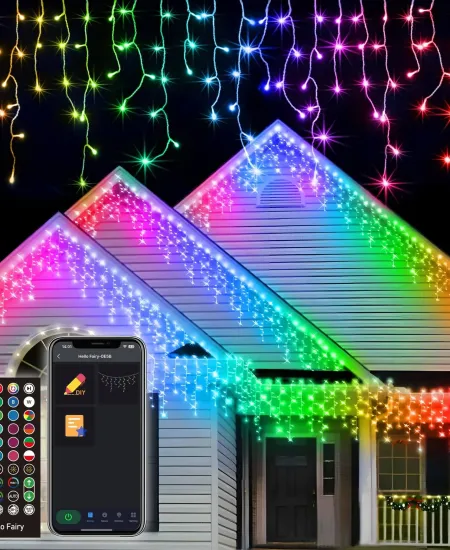A Twinkle in the Winter Wonderland: Are App-Controlled Christmas Lights Reliable in Cold Climates?
Last year, feeling particularly festive and perhaps a bit too ambitious, I decided that the tangled mess of traditional Christmas lights wouldn’t hang from my roofline. Instead, I leaped into the future with app-controlled Christmas lights. You know, the nifty ones you can charm with your smartphone from the comfort of your couch. Let me take you through an enlightening adventure (pun intended!) about whether these high-tech decorations hold their own when Jack Frost really starts nipping at your nose.
What's the Big Deal with App-Controlled Christmas Lights?
I remember unboxing them like it was yesterday. I was all set for my house to be the envy of the neighborhood with these LED beauties that promised millions of colors and the ability to sync with my holiday playlists. The idea of controlling everything through my phone was a huge sell. No more fumbling in the cold with manual timers or switches.
App-controlled Christmas lights use wireless technology, either Bluetooth or Wi-Fi, to connect with applications developed by their manufacturers or third-party apps. This tech allows you to turn them on and off, change colors, set timers, and even choreograph them to music. Curious about what makes lights weatherproof? It's a crucial feature for outdoor use!
Testing Them in the Frosty Realities
The first real test came swiftly. The temperature dropped dramatically one December evening. The crisp, clear skies meant no snow, just bone-chilling cold. I sent a silent prayer to the tech gods as I opened the app to turn on my new sparkling investment.
Here's what I've gathered about their reliability, especially when the mercury dips:
Performance in Low Temperatures
LEDs themselves are generally robust in cold weather. They're actually more efficient in the cold than in heat. The true test, however, was the control technology. Initially, there were no hitches. The lights blinked to life, their colors as vivid as promised. I was thrilled. If you're comparing setups, it's good to know how LEDs perform when tested outdoors.
However, the honeymoon phase wasn’t to last. As the season wore on, I noticed the response time lagging. A bit of digging led to a discovery: batteries in exterior devices (like the control unit mounted outside) drain much faster in cold weather. This was one of those "I wish someone had told me that!" moments. (sunreadylandscaping.ca)
Connectivity Issues
Reliability in maintaining connection is another crucial factor. My lights were Wi-Fi dependent, and the further from the router, the sketchier the connection became. It didn't help that thick, icy walls seemed to add a barrier. I learned the hard way that strategic placement of both the router and the control unit matters more than you think. Setting up a control center for lights can make a real difference. (theverge.com)
Surviving the Elements: Wear and Tear
The durability of the hardware was a big concern. Most app-controlled options are designed to be outdoor-friendly, sure, but how well do they really stand up to serious winter weather? Mine claimed to be weatherproof and for the most part, they were. They survived snow dumps and freezing rain, although I did notice some condensation inside the cover of the control unit. A bag of silicone gel later, and it hasn’t been an issue since. If you're wondering how to tell if lights are truly outdoor ready, here's a handy guide on light safety.
Manufacturer Support and Warranty
Discussing warranties and support might seem about as exciting as watching paint dry, but this is crucial stuff. My smart Christmas lights came with a two-year warranty, which gave me peace of mind. The customer service was responsive when I had concerns about the condensation issue.
The Verdict from A Chilly Zip Code
Overall, my app-controlled lights brought more joy and less frostbitten frustration than the old school string lights—once I got past the initial learning curve. Here’s a rundown:
- Pros: Energy-efficient, customizable, and a real wow-factor with syncing capabilities.
- Cons: Initial setup can be tricky, possible connectivity issues, and don’t forget about the potential for rapid battery drainage in cold temps.
Would I recommend them? Yes, with a few caveats. Plan your setup to ensure good connectivity, be ready for a little troubleshooting, and maybe keep a bag of silica gel handy.
Practical Tips for Frosty Climes
- Check the specs—ensure the temperature range fits your local winter climate.
- Plan the layout—keep your control unit within a good range of your router or consider a Wi-Fi extender.
- Protect your equipment—consider weatherproof cases for any external hardware and a little DIY insulation (hello, duct tape!) might not hurt either.
- Maintenance—regular checks and balances will save you a cold night troubleshooting under the stars.
Embracing new technology with app-controlled Christmas lights can usher in a holiday season filled with brilliant colors and high-tech convenience, assuming you’re prepped for a few bumps along the frosty road. Ready to make your winter nights a lot brighter? Go for it, but keep these insights in mind as you deck the halls!
Final Takeaway
If you're thinking about upgrading your holiday magic, app-controlled Christmas lights are worth a shot. Just remember, the colder it gets outside, the more TLC your gadgets might need. Stay warm out there and let your lights dance away the winter blues!
Subscribe to our email newsletter and unlock access to members-only content and exclusive updates.

Comments